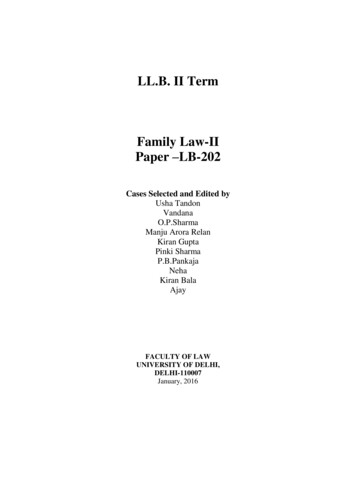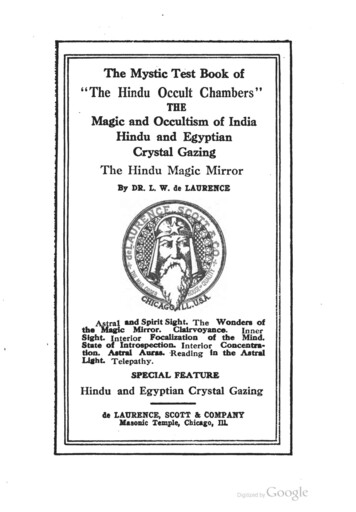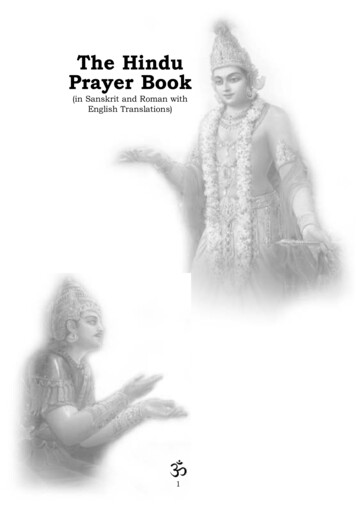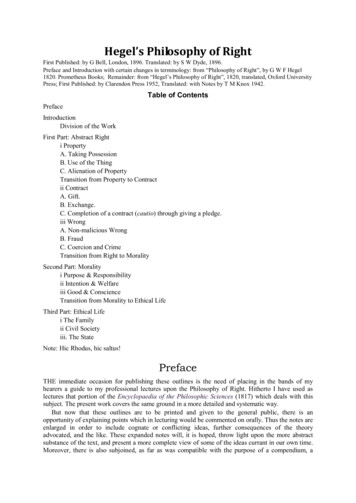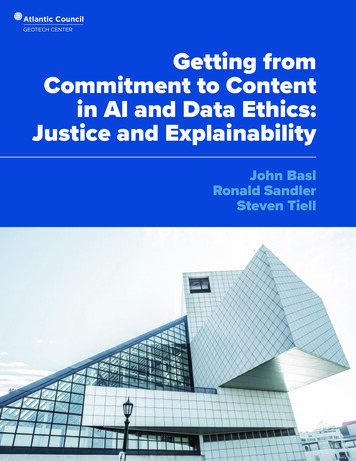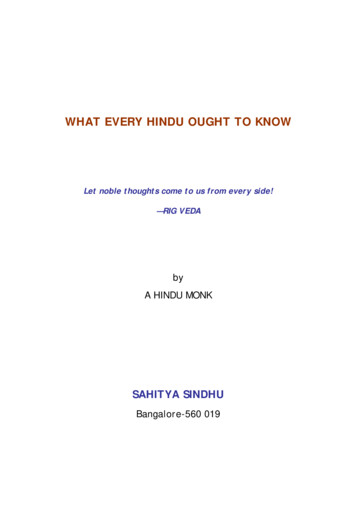
Transcription
WHAT EVERY HINDU OUGHT TO KNOWLet noble thoughts come to us from every side!—RIG VEDAbyA HINDU MONKSAHITYA SINDHUBangalore-560 019
Prakashana:Sahitya SindhuBangalore-560 019Sole Distributors :Rashtrotthana SahityaKempegowda Nagar, Bangalore-560 019First Edition:August19682,500 copiesSecond d Edition:January19725,000,,Reprint:May197510,000 ,,Reprint:December198210,000 ,,Price :Rs. 2-75RASHTROTTHANA MUDRANALAYABangalore 560019
PREFACE TO THE FIRST EDITIONThe sorry spectacle of the Hindu youthbeing unable to face up to the challenges thrownby people of other faiths who are bent upondestructive criticism and malicious propaganda, isthe main motive force behind this attempt. It ismainly intended for this youth though otherHindus can also make good use of the same. If itprovides them with shields of defence, weapons ofoffence when necessary and food for seriousthought and introspection, we deem our object inwriting this booklet to be fulfilled. Our onlyrequest is that this booklet should be carefullystudied and then circulated as widely as ted liberally to the success of this smallproject. Our grateful thanks to them all.Mysore10-7-1968THE AUTHOR
PREFACE TO THE THIRD EDITIONIt is a remarkable tribute to the awakenedHindu consciousness that 8,500 copies of thisbooklet have been sold out in two and a half yearsand the demand for it is still increasing.I wish and pray that this slightly revisedthird edition also will meet with the sameenthusiasm.I offer my hearty thanks to Prakashana:Sahitya Sindhu for bringing out this edition and toRashtrotthana Sahitya for taking upon themselvesthe task of sole distribution.CalcuttaSankranti, 15-1-1972THE AUTHOR
PUBLISHERS' NOTEWe deem it an honour to publish the thirdedition of this small, compact booklet which hasalready proved quite popular among the Hinduyouth, for whom it is mainly intended. Here in anutshell is what every Hindu ought to knowgoading him to do what he ought to do.Words fail us in thanking the author - 'AHindu Monk', who has in simple but scorchingwords tried to rouse the conscience of the Hindusat large - for permitting us to publish this edition.Sankranti15-1-1972
18.19.20.21.22.23.24.25.The Eternal ReligionThe Propagators of HinduismThe Basic Scriptures of HinduismThe Philosophical Systems of HinduismEthical and Moral Principles in HinduismThe Individual and the Society in HinduismWomen in Hindu SocietyHindu SádhanasPlace of Rituals, Temples andFestivals in HinduismA Few Rituals and Sacraments of HinduismReform Movements in HinduismVishva Hindu ParishadSpecial Contribution of Hinduismto World ThoughtHinduism : The Religion UniversalUbiquitous Hindu CultureHindus Outside IndiaCriticisms GalorePeople Living in Glass HousesShould Not Throw Stones!External Dangers Facing the Hindu SocietyThe Menace of MaterialismSecular State or Insecure State?The Internal DangersSome Problems and Possible SolutionsWhat Every Hindu Ought to 73768386
1The Eternal ReligionThe correct name of Hinduism is SanátanaDharma, 'The Eternal Religion.' Being based on theVedas and practised by the ancient Aryan race, itis also called the Vaidika Dharma. 'The VedicReligion' and the Árya Dharma, 'The Religion of theÁryans'. As regards the origin and evolution of theword 'Hindu', Swami Vivekananda says: "This word'Hindu' was the name that the ancient Persiansused to apply to the river Sindhu. Wherever inSanskrit there is an 'S', in ancient Persian itchanges into 'H', so that 'Sindhu' became 'Hindu',and you are all aware how the Greeks found ithard to pronounce 'H' and dropped it altogether,so that we became known as Indians." 1 Somemodern scholars, however, are of the opinion thatthis word also originated in our own country and isvery ancient.1The Complete Works of Swami Vivekananda, Vol. 3, p. 228
2The Propagators of HinduismUnlike most world religions, Hinduism hasno founder. It is not based on the spiritualexperiences of a single individual, but on theintuitions and experiences of a large number ofseers, saints and mystics called 'Rishis.' Theseancient Rishis were only propagating this EternalReligion and were not the founders in the sensethat is normally understood and applied to d and handed down as a greattradition. Religious men of countless generationshave borne testimony to the truth and validity ofthe teachings contained in them. Even today thesespiritual truths can be experimented on andverified in the laboratories of our souls, just as thestatement about natural laws found in text-booksof science can be tested and verified in thelaboratory of science.None the less, Hinduism is as much arevelation as any other religion of the world. Itgoes even a step further and says that it is acontinuous revelation. Hence, according to it, asingle revelation or the revelations of a singleindividual do not exhaust the whole of the Truth.That is why it contemplates the advent of newAvatars, the introduction of new codes of law
What Every Hindu Ought to Know3(Dharmashástras)and the production of neweditions of scriptures.The greatest strength of Hinduism lies inthe fact of its being based upon certain eternaltruths, rather than on a personality howeverexalted he may be. These truths are such thatthey can be verified by anybody at any time.
3The Basic Scriptures of HinduismHinduism is based primarily on the Vedas.'Veda' literally means knowledge or wisdom. It isalso called 'Shruti' which means 'what is heard orrevealed'. All other scriptures go under theomnibus term of 'Smriti' ('what is remembered').Shruti being divinely revealed to the great Rishisof yore in the depths of their mystical experience,its authority is supreme. Smritis are the secondaryscriptures which derive their authority from theShruti. Their business is to explain, elaborate andillustrate the fundamental teachings of the Shruti.However, according to the Hindu view,revelations are not limited to any individual, timeor place. Just as there have been revelations inthe past, they can occur at present or in futurealso. The seer is only a medium to transmit toposterity the insight which he receives. Hence heis no more the inventor of the Veda than Newtonis the generator of the law of gravity.The Vedas are four in number–the RigVeda, the Yajur Veda, the Sáma Veda and theAtharva Veda. The Rig Veda is the most ancientscripture of the world. Lokamanya Tilak, on thestrength of astronomical evidences, concludes thatit is at least 8,000 years old.
What Every Hindu Ought to Know5The Rig Veda consists of hymns which aremostly prayers. The Yajur Veda deals mainly withsacrificial rites. The Sáma Veda contains a portionof the Rig Vedic hymns set to music. These have tobe sung at appropriate stages during a sacrifice.The Atharva Veda, which is a later composition,consists mostly of morals and ethical codes as alsoa few worldly sciences.Each Veda is usually divided into four parts:the Samhitas, the Bráhmanas, the Áranyakas andthe Upanishads. The Samhitas contain prayers andMantras used in sacrifices. Whereas the Bráhmanasgive the 'know-how' of sacrificial rites, Áranyakasteach the art of certain types of meditation, basedmostly on well-known sacrifices. The Upanishadscontain the highest philosophical flights of theVedic sages which can be the pride of the wholehuman race for all time. Schopenhauer, thefamous German savant, has declared: "In thewhole world there is no study, except that of theoriginals, so beneficial and so elevating as that ofthe Upanishads. It has been the solace of my life,it will be the solace of my death." 2Then comes the Bhagavad Gita, the mostpopular of all the Hindu scriptures. The Gita, as itis shortly called is so well-known all over theworld that it has been the second most-translated2Quoted in the Sacred Books of the East, Vol. 1, p. 1xi
6What Every Hindu Ought to Knowwork. Though the Bible ranks first in this regard itshould be remembered that its translations weresponsored by the mighty machinery of the Churchwith the enormous material resources at itscommand. As for the Gita, its beauty, sublimityand universality prompted its admirers to translateit into different languages of the world.There is a verse in Sanskrit which comparesthe Upanishads to a milch-cow and the Gita to itsmilk. In other words, the Gita gives the essence ofthe Upanishadic philosophy in a simple andpracticable form. It is an integral part of theMahábhárata and is in the form of a dialoguebetween Sri Krishna, the great incarnation of God,and Arjuna, the great warrior prince. Thebattlefield was the place of its origination; andserious problems concerning life and death, dutyand devotion, knowledge and meditation werediscussed, and sensible solutions offered whichhold good even to this day. Manliness and selflessdevotion to duty are the keynotes of this greatlittle scripture.Any list of the Hindu scriptures isincomplete without the two great epics, theRámáyana and the Mahábhárata. Though these twogreat books deal primarily with the story of SriRáma and that of the Kuru race respectively, theycan more rightly be called the encyclopedia ofHindu religion and culture. These two popularworks have influenced and inspired the Hindu
What Every Hindu Ought to Know7nation for thousands of years. They are technicallycalled ‘Itihása’ (history) since they contain thehistory of the two most important dynasties thatruled and shaped the destinies of our motherland.The Smritis of Manu, Yájðavalkya andParáshara the Puránas including the famousBhágavata, the Ágamas and the treatises on theDarshanas are the other scriptures forming themagnificent edifice of Hinduism built upon thefoundation of the Vedas. The Smritis are mostlycodes of law intended to regulate Hindu societyfrom time to time, according to the principles ofthe Veda. 3 The Puránas are imaginative workswoven round some historical matters. They aim atteaching religious truths through concreteexamples. The Ágamas are sectarian scripturesdealing with the worship of a particular aspect ofGod and prescribing detailed courses of disciplinefor the worshipper. The Darshanas are schools ofphilosophy. The orthodox schools among them tryto develop, systamatise and correlate the variousparts of the Veda, each in its own way.3They are mostly of historical importance now, as oursociety has changed and cannot subject itself to the lawsmade centuries ago. It is the duty of the present dayreligious leaders to formulate new codes and laws to fit inwith the changed circumstances.
4The Philosophical Systems of HinduismEver since the beginning of civilization, theinnate curiosity of man has been urging him todelve into the mysteries of the universe. Whocreated this universe? Who am I? Where did I comefrom? Where do I go after death? These were thefundamental questions posed by him. Therelentless search for an answer to these basicquestions has led to the origin and evolution ofphilosophy.If the West sought in the external world fora solution, the Hindu sages turned their gazeinwards and discovered their own answers throughmeditation and mysticism. The 'Shaddarshanas' (sixsystems of Hindu philosophy) were the result. 4Darshana means vision of truth. Unlike the West,where philosophy based on pure intellectualismand religion based on a few dogmas of the Churchare at loggerheads, philosophy in Hinduism hasbeen, a 'philosophy of religion' and religion isbased on the findings of philosophy.The six Darshanas are: (1) Nyáya ofGautama (2) Vaisheshika of Kanáda (3) Sánkhya of4The three heterodx systems–Charvaka, Jaina andBouddha–are also included sometimes under the banner ofHindu Philosophy.
What Every Hindu Ought to Know9Kapila (4) Yoga of Patanjali (5) Mæmámsa ofJaimini and (6) Vedánta of Bádaráyana or Vyása.The Nyáya and Vaisheshika advance theatomic theory of creation. Sánkhya propounds thetheory of the animate souls and inanimate matteras the basic factors in creation. Yoga deals mainlywith the control of the mind. Mæmámsa is moreinterested in upholding Vedic ritualism.Last but not the least is the Vedanta, thepinnacle of all these systems. It can easily becalled 'The Philosophy of Hinduism.' Vedántameans culmination of the Vedas. It is based on theUpanishads, the Gæta and the Brahma Sétras ofVyása, 5 and gives the most rational solution to thefundamental problems posed by philosophy.Vedánta calls that Supreme Power whichprojects this universe, sustains it and withdraws itinto itself as Brahman. It holds the individual soul(Atman) to be birthless and deathless, eternal andimmortal. Attainment of liberation is possiblethrough the knowledge of Brahman, by beingdevoted to this Brahman. A liberated soul willnever again return to mundane existence. Theseare its teachings in a nutshell.5Incidentally, these three are known as the Prasthánatrayaor ‘the three basic scriptures leading to the highest goal.’
5Ethical and Moral Principles in HinduismTo ‘love thy neighbour as thyself’ is supposed to be the 'golden rule.' But to the Hindu whobelieves in the oneness of creation, there isnothing extraordinary in this. 'I love my neighbourbecause in the ultimate analysis, my neighbour isalso myself’–that is his line of argument. In factthe sole mission of his life is to realise this'oneness.' To him, spiritual life is impossiblewithout a moral and ethical life. Therefore verygreat stress is laid on the latter.The wonderful Hindu mind has condensedthe whole gamut of ethical and moral principles intwo simple words: Yama and Niyama. Ahimsa,Satya, Asteya, Brahmacharya and Aparigraha–these constitute Yama. Niyama consists ofShaucha, Santosha, Tapas, Svadhyaya andIshvaraprani-dhána.Not to harm others whether in thought,word or deed is Ahimsa. But it is a virtue to bepractised by the strong and the brave, and not bythe weak and the cowardly.Consonance of thoughts, words and deeds isSatya or truth. It goes without saying that thesemust be right and good.Asteya is non-stealing, non-covetousnessincluded.
What Every Hindu Ought to Know11Chastity in thought, word and deed is thecore of Brahmacharya.Not to accept anything from others, morethan what is absolutely necessary for sustenance isAparigraha.Shaucha is purity and cleanliness.Contentment, absence ofcheerfulness constitute Santhosha.greedandAusterity in the form of service, control ofspeech and mind–these are designated as Tapas.Study of sacred literature as also repetitionof sacred Mantras and prayers are termedSvádhyáya.Surrender of the fruits of one's actions, �na.These are the ten cardinal principles ofHinduism.
6The Individual and the Society in HinduismAccording to Hinduism, spiritual freedom orMoksha is the ultimate goal of life. But desires andpassions which obstruct this do exist in man, everstruggling to find an outlet. It is not very easy toget rid of them overnight. Realising this, the greatHindu sages have provided us with right avenuesfor directing and guiding them. Looked at fromthis angle the conception of the four Purushárthas(ends to be striven for, by man) viz, Dharma,Artha, Káma and Moksha–is a unique contributionmade by Hinduism. Acquisition and enjoyment ofmaterial wealth (Artha) and satisfaction of desires(Káma) should always be within the limits allowedby Dharma or righteousness. This helps theirattenuation and man will become fit for Moksha orliberation in due course.With this Moksha in view, Hinduism requiresevery man to pass through the four stages of life,technicallycalledtheAshramas,viz,Brahmacharya (studenthood), Garhasthya (thestage of the householder), Vánaprastha (retiredlife in forest) and Sannyása (life of completerenunciation).Study of sciences (spiritual and temporal)and a life of strict discipline characterised by selfcontrol are the essential features of the firststage. Acquisition, enjoyment and distribution of
What Every Hindu Ought to Know13the good things of life within the framework ofDharma, mark the second stage. The five dailysacrifices known as Pancha Yajnas viz, Devayajnaor sacrifice to gods, Pitriyajna or obsequialoblation to the departed manes, Brahmayajna orstudy of the Vedas, Nriyajna or serving fellowbeings and Bhétayajna or feeding the dumbcreatures, are obligatory on the householderduring this stage. The third stage whereinintrospection is very important is only a steppingstone to the final stage of Sannyása. This laststage which is the acme of life is distinguished byits total renunciation of worldly desires and acomplete dedication to the attainment of Moksha.Every rule has an exception. The ascentfrom Brahmacharya to Sannyása need not alwaysbe gradual. So the scriptures allowed double oreven treble promotion to qualified aspirants. Theycould embrace Sannyása from any stage.Just as the individual's life has been dividedinto four stages to facilitate spiritual evolution,the society also has been divided into four groups(Bráhmanas, Kshatriyas, Vaishyas and Shédras) tofacilitate smooth working.The Bráhmanas were the custodians ofspiritual knowledge. Simple living and highthinking as also acquisition and propagation ofspiritual knowledge–these were their primaryduties. The Kshatriyas protected the society with
14What Every Hindu Ought to Knowthe strength of their arms and were responsiblefor the maintenance of law and order as alsojustice. It was given to the Vaishyas to producewealth and distribute it without being greedy.Those who lived by manual labour and service toothers were categorised as Shédras.There has been a good lot of criticismagainst this Varna system, as this fourfold divisionis often called. It is to be remembered that thisgrouping was based upon the mental make-up andaptitudes of the individuals and as recognition ofthe division of labour that already existed in thesociety and not upon birth. However it isimpossible to examine each individual determinewhat his aptitudes are and then fix his calling. Andso heredity is made to serve as a sort of workingprinciple. Normally the son inherits the trade ofhis father as he shares some of his traits. But thisprinciple was never intended to be applied withan iron-hand. It was flexible and violable. There isa lot of evidence in the scriptures to show thatman's Varna depends upon his mental make-up andthe calling he chooses. There have been severalcases where people born in lower castes haverisen higher by their virtues and those born in thehigher ones have been degraded due to theirvices. Hence it is obvious that the present-daycaste system, with its water-tight compartmentsand mutual animosity is nothing but a grossdegeneration of the once sublime idea thatformed the basis of this division.
7Women in Hindu SocietyNo bird can ever fly on only one of itswings. Women being the 'other-wing' of the societyit is but proper that their role be discussed here.Ideals constitute the very heart and soul ofa nation. Hence a real understanding of the Hindunation and its womanhood would essentiallydepend on that of its ideals. As already stated,Hinduism considers Moksha or spiritual freedom asthe summum bonum of life, whether for man orfor woman. Consequently the disciplines describedand the paths prescribed for the attainment ofthis Moksha are almost identical. Purity, selfcontrol, devotion and austerity are as muchnecessary for woman as for man. HoweverHinduism does not shut its eyes to the differencesthat do exist between man and woman, biologicalas well as temperamental. That is why it hasdefined their areas of activity depending upontheir Svadharma or special characteristics andprescribed slightly different modes of life and discipline.The strength and the soundness of a societyare sustained by those of the family; and woman isthe central figure in a family. Just imagine thetremendous responsibility that is placed on her! AGriha or home is no home but for the Grihini (themistress of the family). Hence the ideal placed
16What Every Hindu Ought to Knowbefore the Hindu woman is that of the idealGrihini, who again is an ideal wife, an ideal friendand an ideal mother–all rolled into one. It is Sætá,Sávitri, Damayanti and Gándhári–the songs of theHindu soil–that have inspired the lives of millionsof Hindu women for aeons, and not Helens orJuliets.Women had plenty of freedom in the Vedicand Epic age. They had equal opportunities andscope, especially in the religious and spiritualfields. They could undergo the Upanayanasacrament, study the Vedas, become teachers oreven ascetics if they wished. But during themiddle ages there was a criminal neglect of theirwelfare.With the advent of modern education, theimpact of science and Western civilization, thingshave changed no doubt, but the remedy seems tobe worse than the disease! Now woman seems towant to 'out-man' man himself! Gettingdiscontented with her role of childbearing andhome-making she wishes to devote herself to someother ‘higher’' activity! Consequently homes areslowly being replaced by hotels! In the name ofeconomic independence, life is tending to becomemore and more hectic, irregular and even vagrant!By engaging herself in activities which prejudicethe work of preservation, the modern Hinduwoman is coming into conflict with her own inner
What Every Hindu Ought to Know17nature. By blindly imitating man, she cannot bethe giver of joy, the inspirer of activity and theconsoler in distress that she has all along been.This is what the world famous scientist Dr. AlexisCarrel says: "The differences existing betweenman and woman . are of a fundamental nature.Ignorance of these fundamental facts has ledpromoters of feminism to believe that both sexesshould have the same education, the same powersand the same responsibilities. In reality womandiffers profoundly from man. Every one of thecells of her body bears the mark of her sex .Physiological laws are as inexorable as those ofthe sidereal world. They cannot be replaced byhuman wishes." 6What then is the solution? "But now femaleeducation is to be spread with religion as itscentre. All other training should be secondary toreligion," 7 says Swami Vivekananda. MahatmaGandhi exhorts our women not to ape the Westbut apply methods suitable to the Indian geniusand Indian environment. Says he: "Theirs must bethe strong controlling, purifying, steadying hand,conserving what is best in our culture andunhesitatingly rejecting what is base anddegrading. This is the work of Sætás, Draupadis,6Man the Unknown, Chapter III, Section 9.7The Complete Works of Swami Vivekananda, Vol. 3, p. 218.
18What Every Hindu Ought to KnowSávitris, and Damayantis, not of amazons andproudes." 8Will our mothers and sisters heed thisadvice?8Hindu Dharma, p. 382-383
8Hindu SádhanasSpiritual disciplines are called Sádhanas.They are paths to perfection, roads to realisationof the truth. Since there are temperamentaldifferences among the individual seekers of truth,Hinduism recognises the need for a variety ofspiritual disciplines or Sádhanas. These Sádhanascan be brought under four broad categories calledYogas: the Karma Yoga, the Bhakti Yoga, the RájaYoga and the Jðána Yoga. Karma Yoga is the pathof disinterested action suited to the active type.Bhakti Yoga, the path of love of God, is mostsuitable to the emotional type. Rája Yoga, thepath of psychic control, is meant for theintrospectives. Jðána Yoga, the path of discrimination and knowledge is ideal for thoseendowed with a sharp intellect and a keen powerof discrimination. However the four qualities ofactivity, emotion, introspection and intellect arefound in everyone though in varying degrees.Hence a balanced combination of all the Yogas,with more of one and less of others dependingupon one's temperament, is desirable for quickresults.Do your work, the duties that fall to yourlot, nicely and efficiently. But be alert; never getattached, either to the work or to the fruitsthereof. This is the essence of Karma Yoga.
20What Every Hindu Ought to KnowLove God with all your heart and soul.Cultivate an intimate loving relationship with Him.Surrender yourself completely to Him. Desire forHim alone and for nothing else. This is the core ofBhakti Yoga.Rája Yoga prescribes an eight-fold disciplineleading to the perfect control of the mind andculminating in the vision of the Truth. Yama andNiyama, the moral and ethical disciplines alreadydescribed, are the first two steps. Ásana (steadyand comfortable posture), Práîáyáma ithdrawal of the senses from their objects),Dháraîa (fixing the attention on the ideal),Dhyána (steady flow of the mind-stuff towards theideal) and Samádhi (perfect concentration on theideal)–these are the subsequent steps in thatorder.Discriminate between the real (the Self)and the unreal (the world-appearance). Give upthe unreal mercilessly. Cling to the Self, theeternal and immortal reality. Hear about It, broodover It and meditate over It. Become one with It.This is the sum and substance of Jðána Yoga.
9Place of Rituals, Temples andFestivals in HinduismPhilosophy without religion becomesmeaningless. Religion without rituals becomesinsipid. The rituals of a religion, like the husk of aseed, preserve its life and make it germinate. It isonly when the rituals are separated from the faithand assumes an independent existence that theybecome mechanical and lifeless.Human beings have not yet reached thoseheights where they can dispense with all sorts ofsymbols and rituals and devote themselves topurely abstract principles. A flag-hoisting, anoath-taking or a convocation is as much a ritual asworship or sacrifice. To give a concrete shape tothe abstract spiritual ideals and to add colour andzest to life, Hinduism recommends theperformance of several rituals. Out of these, a feware obligatory and the rest are optional.Practice of meditation at sunrise, noon andsunset with the repetition of the famous GayatriMantra, 9 worship of God through symbols and9The Gáyatri Mantra is actually a short prayer addressed tothe Supreme God in the orb of the sun. Its meaning is: "Wemeditate upon the effulgence of God Savita. May Heenlighten our intellects!" There is a popular saying that thethree G's - the Gætá, the Ganga and the Gáyatri - form thethree legs of the tripod upon which Hinduism stands.
22What Every Hindu Ought to ed sacrificial fires–these were some ofthe rituals obligatory on almost all the Hindusduring the ancient days. Even to this day, thesehave been kept up though in a modified form, andwith lesser intensity. A wisely planned andsolemnly conducted ritual prepares the ground,creates the atmosphere, suggests the mood andpredisposes the mind so that the spiritual aspirantmay easily detach himself from the world and feelthe mysterious presence of the Supreme Powercalled God.Hinduism considers religion and spiritualityto be purely a personal affair. It concerns with theeternal relationship between the Eternal Soul andthe Eternal God. Hence the Hindu is obligedneither to build a temple nor pay a visit to it onany particular day. To him his own body is thetemple, the abode of the Lord. However, for thesake of the ordinary people who are incapable ofcomprehending this truth, who always need anexternal support for the practice of their religion,temples are recommended. Even the temple isonly an external symbol of this body. In fact, manyof the technical names of the various parts of atemple are identical with the names of the variousparts of the body. Actually the temple representsthe Lord and His creation (the universe) in all itsaspects.
What Every Hindu Ought to Know23Usually the gateway to a temple will be amassive and magnificent construction. When westand in front of it we are made to feel soinsignificant before the Lord of the universe! Aswe proceed inwards leaving behind the grandcarvings and decorations of the outside, we noticethat the sanctum sanctorum itself is small anddark. We can have the darshan of the Lord onlywhen a light is lit up and waved before Him. Thisindicates that we have to leave the grand externalworld outside, direct our minds inward, light upthe lamp of knowledge there and behold the Lordwithin the sanctum sanctorum of our hearts.Ours has been a land of temples. There isno town or village without a temple, be that ofShiva or Vishnu, Devi or Hanuman, Ganesha orSubrahmanya. They are standing monuments tothe continuing spiritual traditions of our country.And they have played a very significant part in thecommunity life of our country, helping to preserveand enrich our religion and culture, arts and craftsthrough játras, rathotsavas and festivals.Festivals connected with certain sacreddays and associated with certain temples or riversor places of pilgrimage, have been another potentfactor in the religious life of our society. Thoughthe rules and regulations of a festival introduce anamount of austerity in personal life, they alsolighten this burden and elevate the mind when
24What Every Hindu Ought to Knowperformed properly. A rathotsava (temple-carfestival) or a mela (religious fair) has its own storyto tell and lessons to teach. The former seems tosignify that if you are too busy to go to the Lord,He Himself will come to you! The latter providesan opportunity for like-minded devotees tocongregate in a place and strengthen oneanother’s spiritual vibrations. That is why theyhave become part and parcel of our life, forcenturies.
10A Few Rituals and Sacraments of HinduismIt will not be out of place here to dilate alittle upon a few of the more important rituals andsacraments that have embellished Hinduism sinceages.Sandhyá, Péja and Homa are the mostimporta
Vishva Hindu Parishad 33 13. Special Contribution of Hinduism to World Thought 35 14. Hinduism : The Religion Universal 38 15. Ubiquitous Hindu Culture 40 16. Hindus Outside India 42 17. Criticisms Galore 43 18. People Living in Glass Houses Should Not Throw Stones! 52 19. External Dangers Facing the Hindu Society 60 20. The Menace of .
